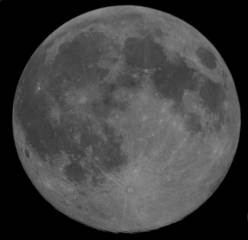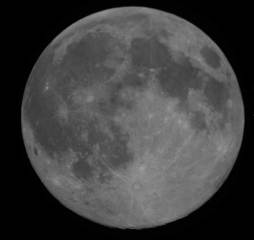Two images of last night’s full moon appear below. One was taken a few minutes before the equinox; the other was taken a few seconds after it. Can you tell which is which? (Hint: the moment at which the equinox occurs has no bearing on the appearance of the moon.)
At the time these pictures were taken, the sun was on the opposite side of the earth. The moon was about 6 hours shy of full (which occurred officially at 5:18 a.m. EDT this morning), but close enough that it would take a trained eye to tell that it’s not quite all the way there.
If you look really, really closely at the south polar region, you can see some sharper relief there than elsewhere. And if you compare the two images long enough, you might be able to convince yourself that the second image shows a little bit less relief than the first, but it might just be a trick of the scale (I wasn’t able to get the images to the exact same scale in Photoshop) or of the focus (the second one is slightly “softer” than the first one).
If that’s enough to convince you that the second shot was taken some 15 minutes after the first, bravo! Me, I went by the time stamp in the image metadata.
I stayed up late to get these shots, though, because of what was happening on the other side of the earth at the time: the center of the sun’s disk was crossing an imaginary plane projected up from the earth’s equator. In other words,the equinoctial point was being passed. You might notice that, in the northern hemisphere, the sun will now rise slightly to the south of east, more and more each day. And it will set slightly to the south of west, more and more each day. Until right around December 20 at 11:44 EST, when the center of the sun’s disk will reach about 23.5° S, appear to pause for a little while, and then head back north. This will be the solstice, a word which comes to us from the Latin solstitium, which, loosely translated, means “the sun stands still.”
The sun won’t actually be pausing in its motion, of course, because it isn’t moving. (At least, its apparent motion across our sky is not at all correlated with the direction of its travel through space.) We are the ones moving, and we will have swung around to the point in our orbit where we perceive the sun as reversing its course.
I was motivated to take these pictures because it’s fairly unusual that the full moon falls this close to equinox; the odds of that happening are pretty long. After all, the equinox can happen on any of the 29.5 days of lunation, and there are only two equinoxes a year. Throw in the solstices, and that’s still only four times a year that the moon has a shot at being full at a particularly exciting moment. I’m sure there’s a way to calculate the closest full moon to an equinoctial or solstitial moment, but I don’t know how to do it. Anyone out there know how?
And, as usual with these full moon posts, here are all the full moons of 2010:








































Always fascinating to read your posts, Ben. Thanks for the clarity. J